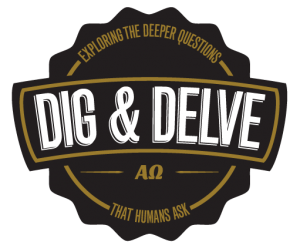It used to be that atheists would point to science and say that they couldn’t believe in God because of science. Now, however, it is becoming less and less possible for any well-informed person to honestly embrace atheism.
The universe is just too complex and too perfectly designed for such an idea. What’s more, every year new discoveries make the idea of the universe coming about by chance or designing itself less and less likely. The more we learn about the intricacies and interconnectedness of biological systems, the farthest reaches of space, or biochemical interactions, the more we all need to accept that there’s got to be a “Designer” of some sort.

Last fall I attended Dig and Delve 2019, a conference which discussed the following questions:
Are multiplying scientific discoveries making it more and more unlikely that the neo-darwinian evolutionary theory is true? Are scientific discoveries making it more and more likely that there must be a “Designer” to account for reality? Does the acceptance of a Designer threaten or ground science? Has belief in a Designer in the past stifled science? Given the scientific and rational issues, which system of thought best describes the Designer? Can you be rational, scientific, and know the Designer?
The Dig and Delve team brought together a biologist, a physicist, a medical doctor, and a philosopher to discuss these issues and to answer the audience’s ‘toughest questions’ in a panel discussion. Two other speakers rounded out this conference.
Dig and Delve Speakers
The biologist is well-known Intelligent Design champion, Professor Michael Behe, author of Darwin’s Black Box, The Edge of Evolution, and Darwin Devolves, and he discusses design and his latest research.
The physicist, Dr. Brian Miller of The Discovery Institute, speaks about design both in space and on earth. His talks are dynamic and a good first pick if you do not want to watch the talks in order.
Professor Robert Larmer, a philosopher, clarifies ideas behind common objections to Intelligent Design and shows when they are not valid.
Dr. John Patrick, professor, medical doctor, and president of Augustine College, speaks about the relationship between science and religion.
Dr. Jonathan Patrick, professor, explains why science needs faith.
The Reverend George Sinclair of Church of the Messiah, and Dig and Delve organizer, introduces the topic and conference in a memorable way.
Dig and Delve Talks
I hope you will find the time to watch some of these talks so that you, too, will see why atheism is becoming less and less scientifically probable. (Note that the descriptions in italics were taken from the Dig and Delve website; those in regular font are from my own notes.)
Can you believe that Christianity is true and evolutionary theory is true? Is it reasonable to say that evolutionary theory merely describes how God created all things? Does evolutionary theory require larger claims that touch on both the universe itself and human experience? This talk will help frame the questions and issues and help people understand the flow of our 2019 conference.
Some say, “Evolution proves that atheism is true,” but what if science shows the universe was actually designed, not evolved?
European science in the Middle Ages was comprised of the study of nature, mathematics and natural philosophy and the church was the patron of science. The story of how this relationship changed and what the consequences are for us today is fascinating.
We need to learn how to approach the different areas of learning. Our God is a God of order, so it is possible to do experiments.
Throughout recorded history, virtually all people — intelligent or not, devout or not — have thought that life was purposely designed. That changed in the mid-19th century when Darwin proposed his theory of evolution. With the development in the early 21st century of sophisticated new tools to probe the molecular basis of life, however, it’s changing back.
We need to look at how life works at the cellular and molecular level to evaluate Darwin’s ideas. The more science progresses, the more evidence there is for design.
Topics Include:
- Why is truth so important?
- Is Intelligent Design theory theology or science?
- You can tell something was designed without knowing its history.
- We need to speak up more about our own stories.
In our post-modern times many see the sciences as a means to power instead of the search for truth that it was in the past. Unbelievably, “science” is, in some cases, becoming what those in power believe, regardless of the facts.
Advances in physics and planetary science over the past century have consistently yielded evidence that the universe and our planet are the results of intelligent design. Dr. Miller will explain how recent discoveries from research on the Big Bang and on how the laws of physics were carefully chosen to allow for life in the universe point to a Creator. In addition, he will describe evidence for design in our planet, moon, sun, and galaxy.
“A little science can bring people away from God but a lot of science inevitably brings them back.” When one sees the incredible ‘coincidences’ in the physical world, there are two possible responses: “Wow, there is a Creator!” or “Let’s try to explain it away by supposing there are many universes.”
Any appeal to divine intervention to bridge what seems to be otherwise unbridgeable gaps in naturalistic explanations, for example the origin of life, are routinely dismissed on the grounds that they commit the fallacy of the “God of the gaps’. Dr. Larmer will examine this presumed fallacy and argue that this routine dismissal is unjustified.
If God ever does intervene in nature, there will be gaps; in the miracle of the fish and the loaves, the fish’s existence will have a gap in its explanation. Don’t model the universe as a machine that God set going and then ignores; think of it as a musical instrument that God interacts with. Our increased knowledge of the cell since Darwin’s time has made it a whole lot harder to explain the cell in terms of natural causes.
Topics include:
- Is the universe fine-tuned for us, or are we fine-tuned for it?
- The amount of time that is available for evolution.
- Life is nanotechnology, and as science advances it is becoming increasingly difficult to rationalize away the evidence for design.
- What about imperfect or poor design?
- And over a dozen more topics.
The Darwinian mechanism of natural selection sifting random mutations helps species adapt to their environments. With the development of new laboratory tools to sequence DNA, however, we now know it does so mostly by degrading pre-existing genetic information.
Using new DNA sequencing techniques, it is now possible to study mutations in bacteria over tens of thousands of generations. These show that Darwin’s mechanism is dominated by the squandering of important genetic information for short term gain. What’s more, it seems that evolutionary biologists have no detailed, mechanism-based answer to this problem.
Origin of life research over the past few decades has consistently demonstrated that the driving tendencies in nature work against the coalescence of simple chemicals into a functional cell. In addition, advancements in thermodynamic research indicates that the origin of life is theoretically impossible without intelligent direction. Moreover, analyses of a minimally complex cell continuously identify characteristics which only correspond to objects of intelligent design. Dr. Miller will explain this ever-growing body of evidence and identify the stages where design is required.
Large biomolecules (like protein and DNA) tend to fall apart; every natural process does the opposite of what we need to produce life.
Contrary to proponents’ claims, methodological naturalism is not metaphysically neutral. Consequently, its acceptance as a practice requires justification. Unfortunately for its advocates, attempts to justify it are failures. It cannot be defended as a definition, or a self-imposed limitation of science, nor, more modestly, as an inductively justified commitment to natural causes. As a practice, it functions not to further scientific investigation, but rather to impose an explanatory straitjacket.
What one thinks to be the nature of reality cannot be neatly separated from methods one uses to study it. Accepting methodological naturalism guarantees that if supernatural causes exist, they can never be recognized. The Intelligent Design movement is about recognizing design, not about figuring out who the designer is.
Topics include:
- Historically, it is difficult to demarcate science from non-science.
- Is there evidence against natural design?
- How can one engage with the culture about Intelligent Design?
- Some books.
Final Thoughts
Note that the question being discussed at Dig and Delve 2019 was whether or not science supports the existence of a God. This is where the big battle in our culture is: is there something more than just physical reality? In other words, does God exist?
However, behind the main battle line are other important debates that can be divided into two types.
- The first centers on who this Designer God is, and Dig and Delve 2019 mentioned a few times that it makes sense to see him as the God of the Bible (rather than Allah of the Koran or a more diffuse deity as those of Eastern thought).
- The second centers on how this Designer did his work: how much time did he take and what processes did he use? Dig and Delve speakers carefully avoided getting involved in these issues—this was a conference to discuss how science shows that a Designer exits. Its goal was not to debate how he does his work.
I hope you will listen to these talks whether or not you currently acknowledge a Designer. And if, by grace, you come to the point where you feel a compulsion to acknowledge that God exits, then know this—only Christ can make you right with him, as Pastor George Sinclair pointed out.
Imagine, it is possible for us to have a good relationship with the Designer of the universe! This is good news that we can share with others, but first we may need to show them that a Designer exists. These talks will help equip you to point people to God’s great proof for himself, the world he made.
This conference was aimed at college students, but high school students and anyone else would benefit as well. I highly recommend the conference videos to all.
—
Disclosure: I am not compensated for telling you about this conference.








